Elderberry (Sambucus nigra) is a wonderful, deep acting immune tonic famed throughout history for its use as a preventative and remedy for cold and flu. The berries are rich in nutrients and antioxidants, are potently anti-viral, modulate the immune response and have an anti-inflammatory effect. This recipe is a winter staple.
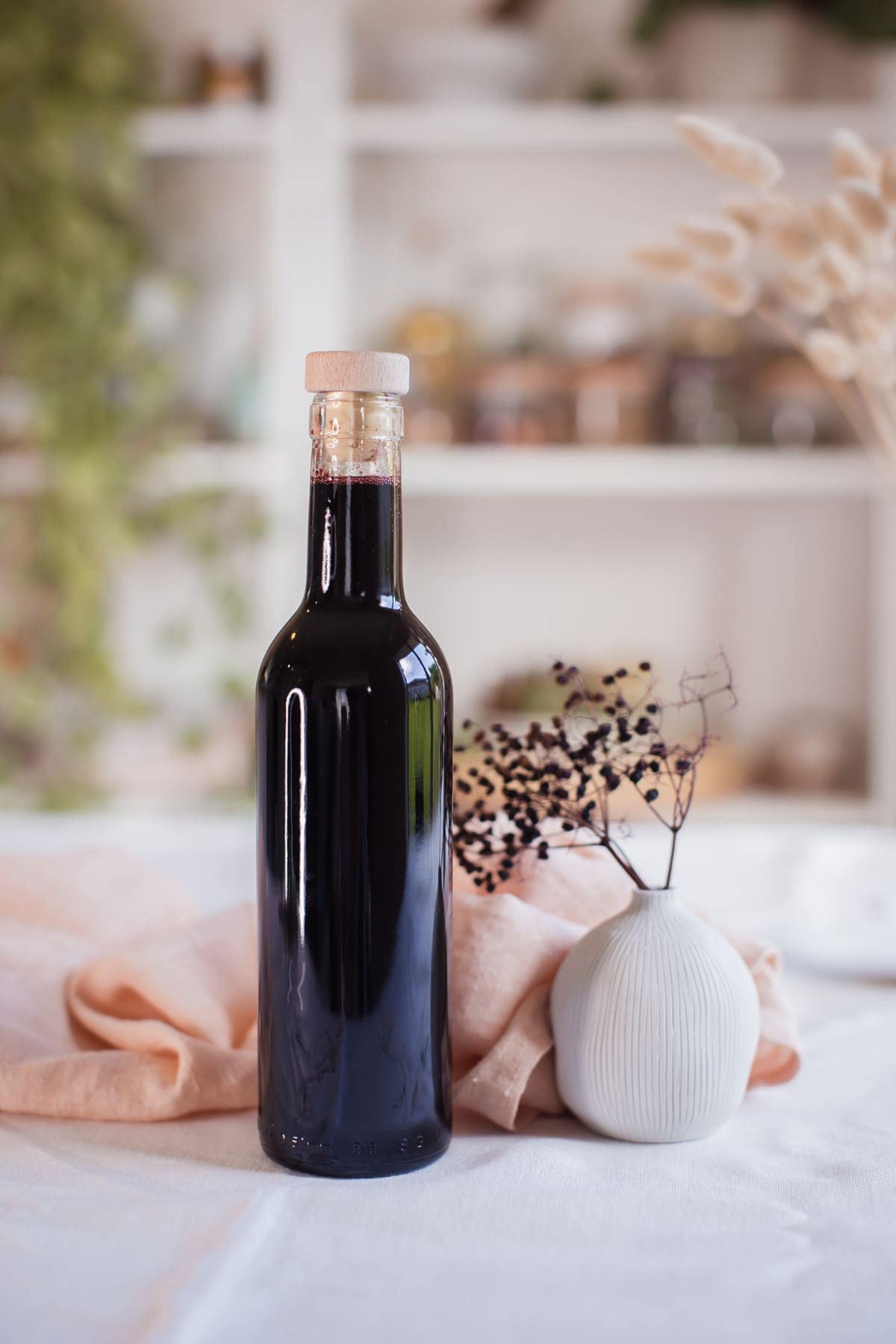
Elderberry syrup is a recipe as old as the hills, and in its most basic form, involves the simmering of the berries in water, with honey added at the end to thicken and preserve.
The syrup can be taken by the spoonful daily during the cooler months as a preventative, with a larger dose used during acute infection.
This is food as medicine as its finest!
🧚♀️ Elder folklore
Elder (Sambucus nigra) is a beautiful shrub/tree with small, frothy, creamy-white flowers during spring to summer, giving way to drooping bundles of purple-black berries by summer’s end to autumn.
There’s much folklore surrounding these beauties with themes of sorrow, death, magic, protection, witches and faeries.
The associations with sorrow and death come from old legends that told the elder tree was used to fashion the Holy Cross, and that Judas was hung from its branches.
There was also much superstition regarding the improper acquisition of its branches and wood. It was believed a dryad (wood nymph) by the name of Hylde-Moer, the Elder Mother – Queen of the Underworld, lived in the tree, and that failing to ask her permission to cut the wood would anger her and lead to misfortune and an inevitable haunting.
Elder trees were otherwise seen as protective, driving away evil spirits and witches.
The leaves were hung on doorways and windows of homes, if worn on the body it would protect against physical and psychic attack, if grown in the garden it would protect the household against sorcery and physical illness, and the leaves and berries were scattered in the four directions in the name of a person, place or object to bless it (Cunningham, 2014).
Elder is probably most closely associated with the Faerie realms. The blossoms have a rather narcotic scent, so it was said you would swiftly dream of faeries if you were to fall asleep under its branches (I think I’d quite like that!).
The hollow stems from the branches were often crafted into wind instruments like the pan-pipe or flute – another association with the faeries, as they love to flit and dance along to Pan’s pipes (Pan, in Greek mythology, is God of the wild, the woods and fields).
Much of what I’ve written above has been summarized and referenced from M. Grieve’s ‘A Modern Herbal’ (1931), a fabulously thick book with the most detailed sections on herbal folklore and mythology – more often than not missing from our modern texts.
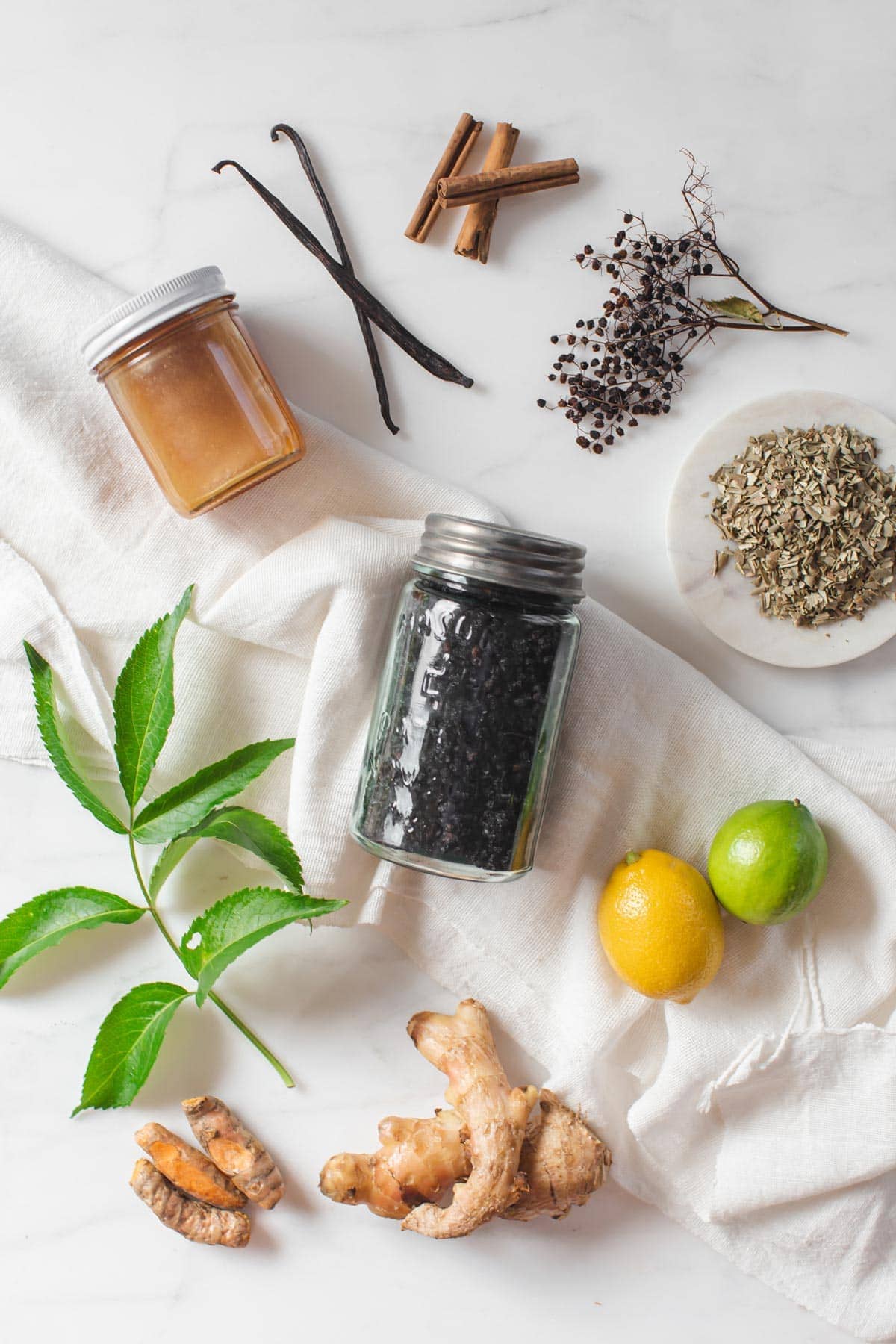
🌡 Elder medicinal uses
All parts of the Elder tree can be used medicinally, the bark, leaves, berries and flowers. The bark and leaves are more potent, while the berries and flowers are milder in action and feature widely in modern herbal medicine.
M. Grieve says of Elder – its uses are manifold and important, I’m going to keep this little blog to a discussion on the berries though, otherwise it might turn into a novel!
Elderberry is one of the most-used medicinal plants in the world. It has been used as far back as the Roman times for a range of applications and ailments – natural hair dye, rheumatism (musculoskeletal diseases), syphilis, colic, diarrhea, as a laxative, as an emetic, for epilepsy and piles, to give a few examples.
That’s not to mention its varied culinary uses – think elderberry pie, wine, vinegar, jam, chutney and ketchup – pure food as medicine! (Note – the berries must never be eaten raw due to toxic compounds rendered neutral on cooking).
🦠 Elderberry syrup benefits
The most important traditional uses however are today supported by evidence – and they are for its use as an antioxidant [1, 2], an anti-viral agent [3, 4, 5], immune modulator [6], remedy for the common cold/flu including symptoms such as fever, aches, pains, cough, and congestion [7], more often than not delivered in the form of a homemade elderberry syrup.
I've written more on elderberry and other great immune herbs here.
🌳 Sourcing
If you’re going to wild harvest elderberry, please be up to speed with your plant identification, as it has a few toxic lookalikes.
If you’re unsure, it’s much safer to purchase the dried Sambucus nigra berries (organic) from a reputable supplier.
🍯 How to make elderberry syrup
The fun part! Before we begin – the recipe in its most basic sense involves simmering elderberries with water, straining them out then adding honey – you can make the recipe your own by adding citrus zest, spices, and even some complementary herbs, which I have done here.
Step one is to make a herbal decoction, which in simple terms, is a long simmering of plant material that are course in nature – ie your berries, roots or bark.
So, combine your fresh or dried elderberries with water, then add any tougher ingredients like cinnamon sticks, vanilla, and ginger root. It doesn’t hurt to add your citrus here too purely for extra flavour.
A note on water - distilled is ideal to prevent microbial growth.
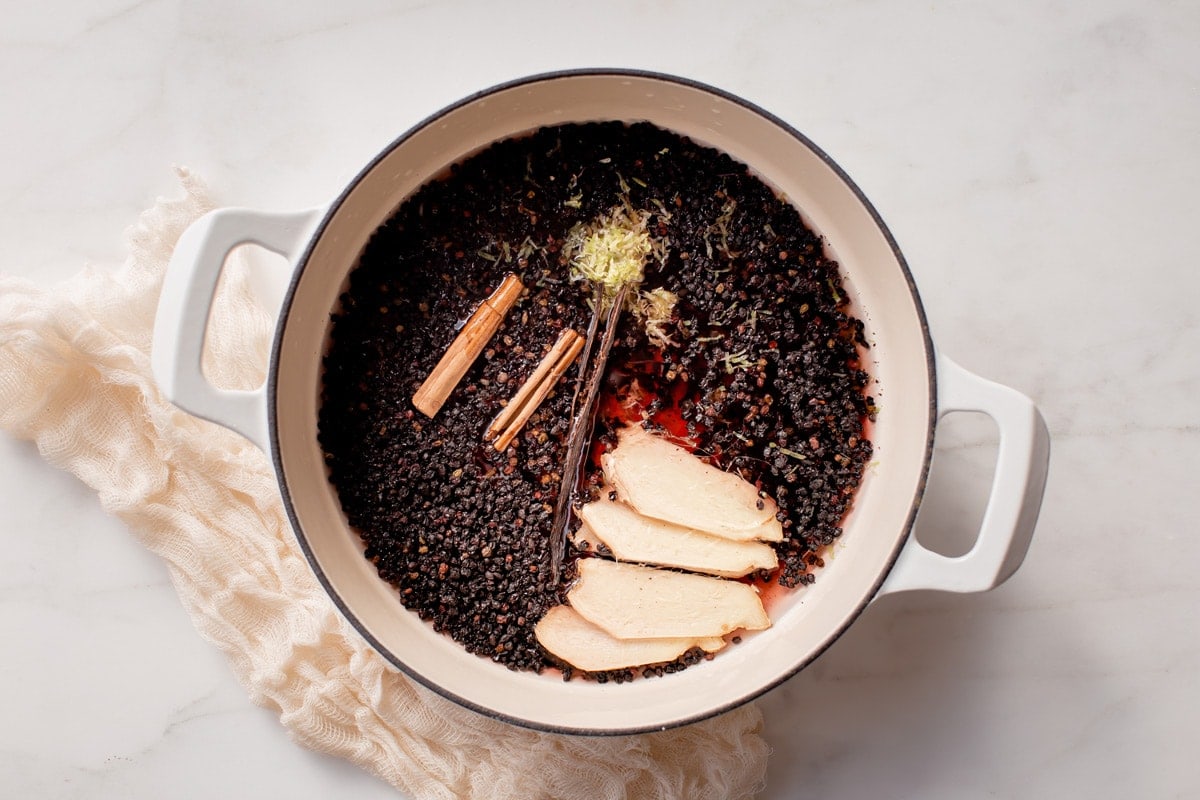
Cover and bring to a boil, then reduce it to a simmer and let it cook for 20 minutes, the amount of liquid should reduce by about half.
If you have more delicate herbs you’d like to add to the recipe – leaves, fine stems, flowers (for example – olive leaf – another great anti-viral) then add them in the last 5 minutes of cooking, or in the next step.
Once the decoction is made, take the lid off and remove from the heat. Leave it to steep another half hour – oh my God it smells delicious at this point!
Once cooled, strain the mixture through a cheesecloth, nut milk bag or similar, pressing out as much of the liquid as possible. I like to do this over a pyrex jug.
You can now discard the berries/herbs/spices, and stand the jug of freshly squeezed liquid in a pot with hot water.
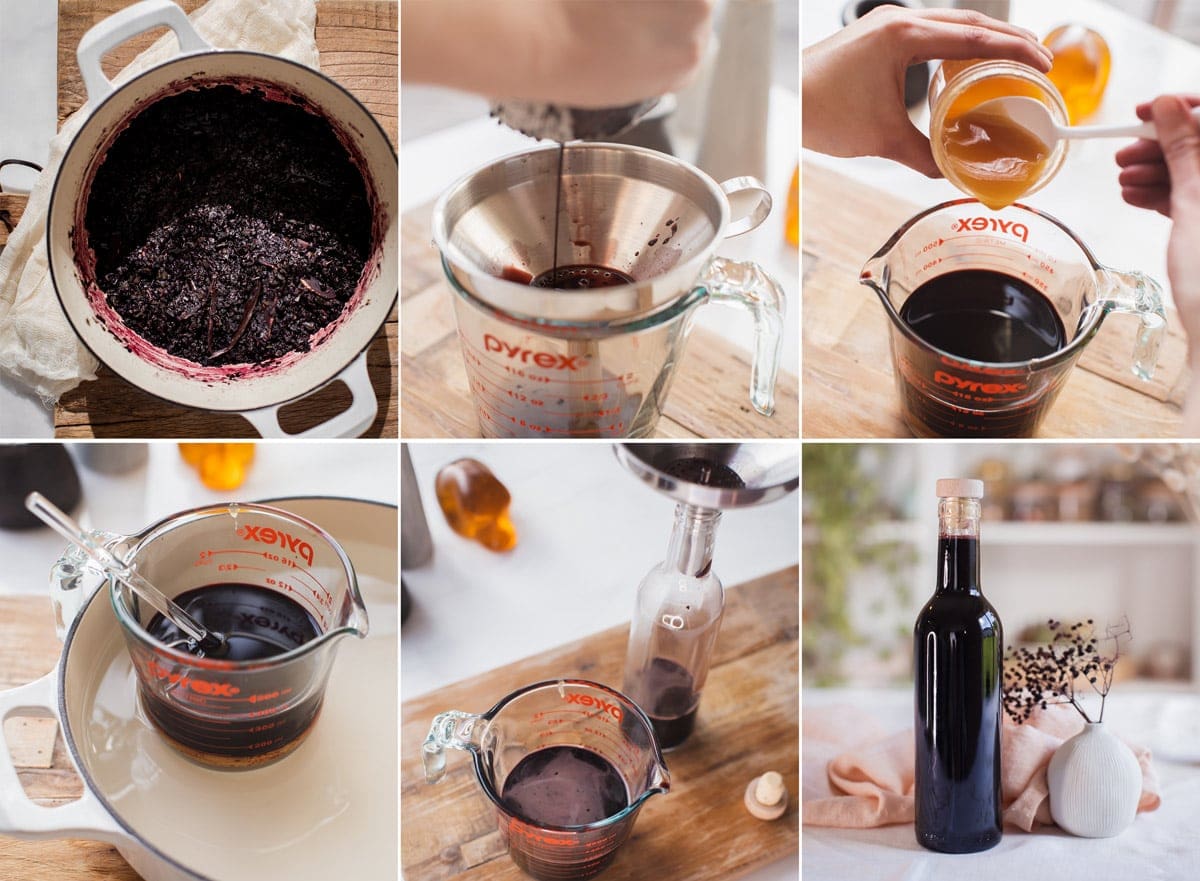
From here, add honey – which will act as a natural preservative – use half the remaining volume in honey for a lighter syrup, and equal parts for something thicker (and sweeter). Stir well over low heat until fully dissolved.
The full dissolving of honey is important, if it separates in the fridge, then it will leave behind a solution without sufficient sugar to preserve, leading to microbial growth.
Add liquid to a sterilized glass jar or bottle with a cap, gently shake, label and date, and store in the fridge.
🥄 Dosing guide
I like to take a tablespoon daily during winter. If you’re actively fighting a cold, increase to three times daily.
For children and the elderly, a teaspoon daily is a good preventative, increasing the dose to three times daily during infection.
For small children, half a teaspoon daily is adequate, increasing the dose to three times daily when fighting a cold.
👩🍳 Storage
- Store in the fridge for up to 3 months
- To extend shelf life, you can add a little brandy
⚡️ Cautions
Cooked black elderberry has no known contraindications, though because this recipe uses honey, it’s not to be used in babies (under age 1).
There is insufficient data to confirm safety during pregnancy or while breastfeeding, and there are no known drug interactions to date [8].
Avoid uncooked berries, and be sure to use black rather than red elderberry, as the red variety are toxic.
Again – if you’re wildcrafting game isn’t strong, don’t wing it, purchase from a trusted supplier.
💭 Tips and tricks
- You can use fresh or dried berries, if using fresh, then use twice the amount of dried
- Use a smaller pot than I have here – the larger the surface area, the quicker the water evaporates. A smaller pot will give you a better result, I used a larger pot so you could better see what the mixture looks like inside
- If you’re adding extra herbs as I like to – for example, a few tablespoons of olive leaf (another great anti-viral), then adjust the water content accordingly
- Use more honey for a thicker syrup
- For a vegan alternative, use pure maple syrup in place of honey
- This is best used during the winter months, particularly so if you’re feeling run down or vulnerable, or if you’ve been around people who are sick
- Works incredibly well when taken at the very first sign of illness, reducing the severity of symptoms and speeding up your recovery time. This is because elderberry blocks the virus from entering the cell, preventing its replication, and therefore lowering its virulence
That's it my loves, happy experimenting, don't be too rigid with the recipe - have a play with it, make it your own,
Lauren. X
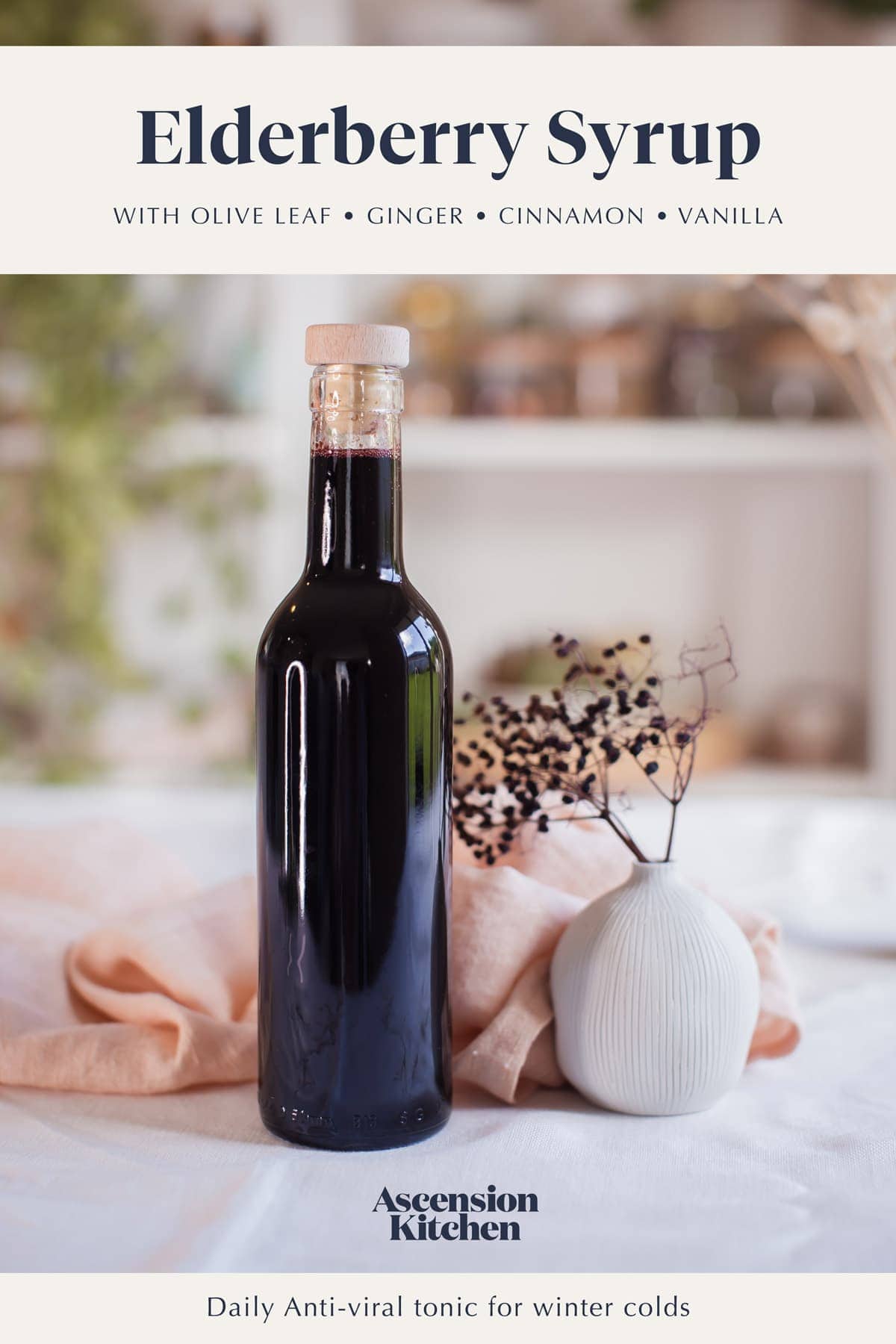
📖Recipe
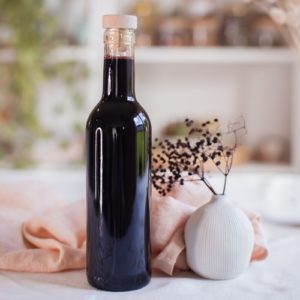
Homemade Elderberry Syrup
Equipment
- Saucepan
- Funnel
- Cheesecloth
- Pyrex jug - at least 500ml (1/2 quart) capacity
- 500ml (1/2 quart) glass bottle with lid
Ingredients
Basic elderberry syrup
- 1 cup dried elderberries organic, 100g
- 3 cups water
- 3/4 cup honey, such as Manuka
Flavourings to customise
- 1-2 cinnamon sticks
- 1-2 whole vanilla beans, split down the middle
- Zest of one lemon
- Zest of one lime
- 2 inches ginger root and or turmeric root, sliced
- 2 tablespoons other herbs, such as olive leaf (anti-viral)
Instructions
- First, make a strong decoction by combining the dried elderberries with water and any other additional spices, citrus zest and herbs (coarse, not delicate) in a saucepan, cover and bring to a boil, then reduce to a simmer for 20 minutes, reducing the liquid by half.
- Remove the decoction from heat and take off the lid, let stand and steep for a further 30 minutes. If you want to add a small amount of delicate complementary herbs (leaves, flowers) the add them here (I used olive leaf - another great anti-viral).
- Once cooled, set a funnel over a pyrex jug, and strain out the mixture using a cheesecloth. Press the cheesecloth tightly to extract every last drop, then discard or compost the plant material.
- To the pyrex jug, add honey - half the volume of liquid for a thinner syrup, and equal the amount for a thicker but sweeter syrup. Place the jug in a saucepan filled with a little hot water, stir well over low heat to dissolve the honey fully.
- Pour syrup into a sterilised glass jar with a tight fitting cap/cork, shake well, label, date, and store in the fridge.
- Dosage: up to one tablespoon a day for adults, increasing to three tablespoons maximum if fighting a cold. For small children, 1/2 a teaspoon a day is adequate, increasing to 1/2 teaspoon three times daily if sniffly. For older children, 1 teaspoon daily, increasing to 1 teaspoon three times daily as needed.
Notes
- You can use fresh or dried berries, if using fresh, then use twice the amount of dried
- Use a smaller pot than I have here – the larger the surface area, the quicker the water evaporates. A smaller pot will give you a better result, I used a larger pot so you could better see what the mixture looks like inside
- If you’re adding extra herbs as I like to – for example, a few tablespoons of olive leaf (another great anti-viral), then adjust the water content accordingly
- Use more honey for a thicker syrup
- For a vegan alternative, use pure maple syrup in place of honey
- This is best used during the winter months, particularly so if you’re feeling run down or vulnerable, or if you’ve been around people who are sick
- Works incredibly well when taken at the very first sign of illness, reducing the severity of symptoms and speeding up your recovery time. This is because elderberry blocks the virus from entering the cell, preventing its replication, and therefore lowering its virulence
- This recipe yields approximately 37 tablespoons, enough for daily use for one person for just over a month
- Nutrition panel is an estimate only, based on one tablespoon

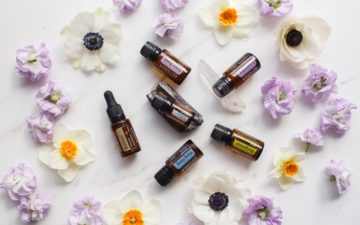
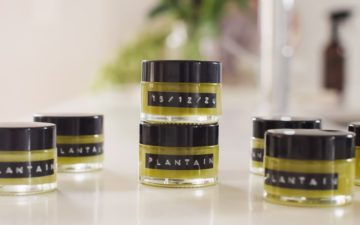
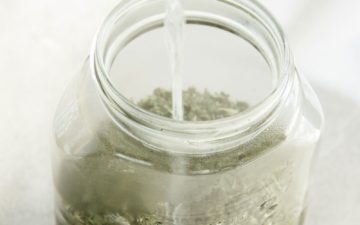
Catherine Byrd
Can you recommend a brand of organic dried elderberries? Thanks!
Lauren Glucina • BNatMed, AdDip NutMed
Hi Catherine, I can only speak to my locals - Austral Herbs in Australia, Cottage Hill Herbs in NZ 🙂